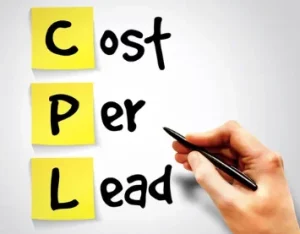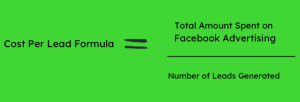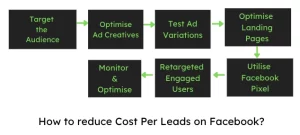How to Reduce Cost per Lead on Facebook?
Businesses must reduce their cost per lead on Facebook to optimize their ad budgets and marketing campaigns. As more companies use Facebook advertising, they realize that generating leads at a lower price is essential to maximizing ROI.
Facebook advertising is a powerful tool that lets businesses reach and engage their target audience with unprecedented accuracy, driving results and boosting growth in the digital age.
Let us understand the relevance of Facebook Advertising and why should the cost per lead be less?
What is Cost Per Lead?
Cost per lead (CPL) in digital marketing measures how much a business spends to get a single potential customer. It’s calculated by dividing the total cost of marketing campaigns by the number of leads generated over a specific time.

- CPL is a crucial metric for businesses because it helps them evaluate how well their lead-generation efforts are working and how cost-effective they are.
- By analysing CPL, companies can measure the ROI of their marketing campaigns and compare the cost of acquiring leads from different channels or strategies.
- Reducing the cpl marketing is a common goal for businesses as it allows them to optimise their marketing budgets and generate a higher volume of leads for the same investment.
- By implementing strategies to lower the CPL, businesses can improve their overall marketing performance, increase their lead generation capabilities, and drive more revenue.
Read: Complete guide to social media advertising
What does it mean to reduce cost per lead on Facebook?
Reducing the cost per lead on Facebook means implementing strategies to lower the average amount of money you spend on acquiring each potential lead or customer through your Facebook advertising campaigns. In other words, it involves finding ways to generate leads at a more cost-effective rate.
The cost per lead (CPL) is calculated by dividing the total amount spent on Facebook advertising by the number of leads generated.

For example, if you spent $500 on Facebook ads and obtained 100 leads, your CPL would be $5.
By reducing the cost per lead, you can use your advertising budget more efficiently and maximise the return on investment (ROI) from your Facebook campaigns. This allows you to generate more leads while spending less money per lead acquired.
Lowering the cost per lead on Facebook typically involves optimising various aspects of your advertising strategy, such as targeting the right audience, creating compelling ad creatives, optimising landing pages, conducting A/B testing, and utilising data-driven insights to refine your campaigns.
The goal is to improve the effectiveness of your ads and increase the conversion rate, ultimately reducing the amount you spend on acquiring each lead.
How to Reduce Cost Per Lead on Facebook?
To reduce the Cost Per Lead (CPL) on Facebook, consider implementing the following strategies:

Target the right audience:
Define your target audience clearly and use Facebook’s advanced targeting options to reach the most relevant users. Refine your audience based on demographics, interests, behaviours, and custom audiences to ensure your ads are shown to people who are more likely to become leads.
- Right targeting ensures that your ads reach a more relevant audience.
- By reaching the right audience, you increase the chances of attracting users who are genuinely interested in your offer.
- Relevant targeting reduces wasted ad spending on irrelevant users unlikely to convert into leads.
- It improves your ads’ click-through rate (CTR) and engagement, increasing the likelihood of conversions.
- With a more targeted audience, you can focus your budget on the most promising segments, optimising your ad spend.
- Ultimately, the right targeting helps you lower the cost per lead by improving the efficiency and effectiveness of your Facebook campaigns.
Optimise your ad creatives:
Create compelling and visually appealing ad content that grabs the attention of your target audience. Use high-quality images or videos, compelling headlines, and persuasive ad copy that clearly communicates the value proposition of your offer. A strong ad creative can improve engagement and conversion rates, lowering your CPL.
- Optimised ad creatives capture the attention of your target audience and generate higher engagement.
- Compelling visuals and persuasive messaging increase the likelihood of users clicking on your ads.
- Improved click-through rates (CTR) result in more visitors reaching your landing pages and converting into leads.
- Ad creatives that clearly communicate the value proposition of your offer attract more qualified leads.
- Testing and refining ad creatives based on data-driven insights help identify the most effective elements, lowering the cost per lead.
- By continuously optimising your ad creatives, you can increase conversion rates and generate more leads at a lower cost on Facebook.
Test different ad variations:
To lower your cost per lead (CPL), run A/B tests by creating multiple ad variations with different images, headlines, formats, and calls to action. Test each variation to find the elements that resonate most with your audience and produce the best results. Continuously optimise your ads based on these insights.
- A/B testing allows you to identify the most effective ad elements and optimize your campaigns accordingly.
- You can learn what resonates best with your target audience by testing different variations of headlines, images, ad formats, and calls to action.
- Testing helps improve click-through rates (CTR) and conversion rates, leading to a lower CPL.
- It also provides insights into audience preferences so you can tailor your ads to maximize engagement and conversions.
- Continuous testing and optimization enable you to refine your campaigns over time, achieving better results and cost efficiency.
- By leveraging data-driven insights from testing, you can make informed decisions that reduce the cost per lead and improve the overall performance of your Facebook ads.
Optimise landing pages:
Ensure that your landing pages are optimised for conversions. Design them to align with your ad’s message and provide a seamless user experience. Optimise the placement and visibility of your lead capture forms, and ensure that the form fields are easy to fill out. A well-optimised landing page can increase the conversion rate and lower your CPL.
- Optimized landing pages provide a seamless user experience, increasing the chances of conversion.
- Clear and persuasive messaging on landing pages reinforces the value proposition of your offer, encouraging users to take action.
- Well-designed landing pages with prominent lead capture forms make it easier for users to submit their information.
- Improved conversion rates on landing pages lead to a lower cost per lead.
- A/B testing and optimization of landing pages help identify the most effective layouts and elements for maximising conversions.
- By continuously optimising landing pages, you can enhance the overall user journey and generate more leads at a lower cost on Facebook.
Utilise Facebook Pixel:
Install the Facebook Pixel on your website to track conversions accurately. This will enable you to measure the effectiveness of your Facebook campaigns, optimise for specific conversion events, and refine your targeting and messaging to improve your CPL.
- Facebook Pixel enables accurate tracking of conversions and campaign performance.
- It provides valuable data insights to optimise and refine your targeting and messaging.
- By leveraging Facebook Pixel data, you can optimise your campaigns for specific conversion events and improve your cost per lead.
- Facebook Pixel helps retarget engaged users, increasing the chances of converting them into leads.
- It provides valuable attribution data to understand the impact of your ads and allocate your budget effectively.
- Utilising Facebook Pixel empowers you to make data-driven decisions and continuously improve the efficiency of your lead-generation efforts on Facebook.
Retarget engaged users:
Implement Facebook’s retargeting feature to reach users who have previously interacted with your ads or website. Retargeting engaged users can increase the likelihood of converting them into leads.
Customise your retargeting campaigns with personalised messaging to nurture these potential leads and reduce your CPL.
- Facebook Pixel enables accurate tracking of conversions and campaign performance.
- It provides valuable data insights to optimise and refine your targeting and messaging.
- By leveraging Facebook Pixel data, you can optimise your campaigns for specific conversion events and improve your cost per lead.
- Facebook Pixel helps retarget engaged users, increasing the chances of converting them into leads.
- It provides valuable attribution data to understand the impact of your ads and allocate your budget effectively.
- Utilising Facebook Pixel empowers you to make data-driven decisions and continuously improve the efficiency of your lead-generation efforts on Facebook.
Monitor and optimise:
Continuously monitor the performance of your Facebook campaigns. Analyse key metrics such as CTR, conversion rate, and CPL. Identify underperforming ads or targeting options and make data-driven optimizations to improve your results.
- Monitoring campaign performance allows you to identify underperforming ads or targeting options.
- By analysing key metrics such as CTR, conversion rate, and cost per lead, you can pinpoint areas for improvement.
- Continuous optimization based on data-driven insights helps refine your campaigns and lower the cost per lead.
- Making informed adjustments to targeting, ad creatives, and landing pages improves overall campaign effectiveness.
- Regular monitoring and optimization ensure that your budget is allocated to the most impactful strategies, maximising ROI.
- You can drive better results and achieve a lower cost per lead by actively monitoring and optimising your Facebook campaigns.
Conclusion
Reducing the Cost Per Lead (CPL) on Facebook is essential for maximising advertising budgets. To achieve this, target the right audience, optimise ad creatives, conduct A/B testing, optimise landing pages, utilise Facebook Pixel, and retarget engaged users.
Monitor campaign performance and make data-driven optimizations. Need help optimising your ad campaigns? Contact Noboru World at hello[at]noboruworld.com for expert assistance. Take action now to lower your CPL and boost your lead generation on Facebook.
FAQ
What is the Cost Per Lead (CPL) on Facebook Advertising?
Cost Per Lead (CPL) on Facebook is a metric that measures how much it costs advertisers to acquire a new lead or potential customer through their Facebook ad campaigns.
A lead is typically someone who has shown interest in a product or service by taking a specific action, such as filling out a contact form, signing up for a newsletter, or downloading an ebook.
How is CPL Calculated on Facebook?
CPL is calculated by dividing the total amount spent on a Facebook ad campaign by the number of leads generated. The formula for CPL is:
CPL = Total Ad Spend / Number of Leads Generated
For example, if you spend $500 on a Facebook ad campaign that generates 100 leads, your CPL would be $5 per lead.
What Strategies Can Help Reduce CPL on Facebook?
To lower your Cost Per Lead on Facebook, consider implementing the following strategies:
-
- Audience Targeting: Refine your audience targeting to reach users more likely to be interested in your offer, thus improving the quality of leads.
- Ad Creatives: Create compelling ad creatives and ad copy that resonate with your target audience and encourage them to take action.
- A/B Testing: Conduct A/B tests to optimize ad elements such as headlines, images, and call-to-action buttons to find what performs best.
- Landing Pages: Ensure your landing pages are user-friendly, load quickly, and provide a seamless experience for users who click on your ads.
- Lead Magnets: Offer valuable incentives like ebooks, webinars, or exclusive discounts to encourage users to provide information.
- Ad Scheduling: Consider running ads during peak engagement times to maximize your chances of generating leads.



